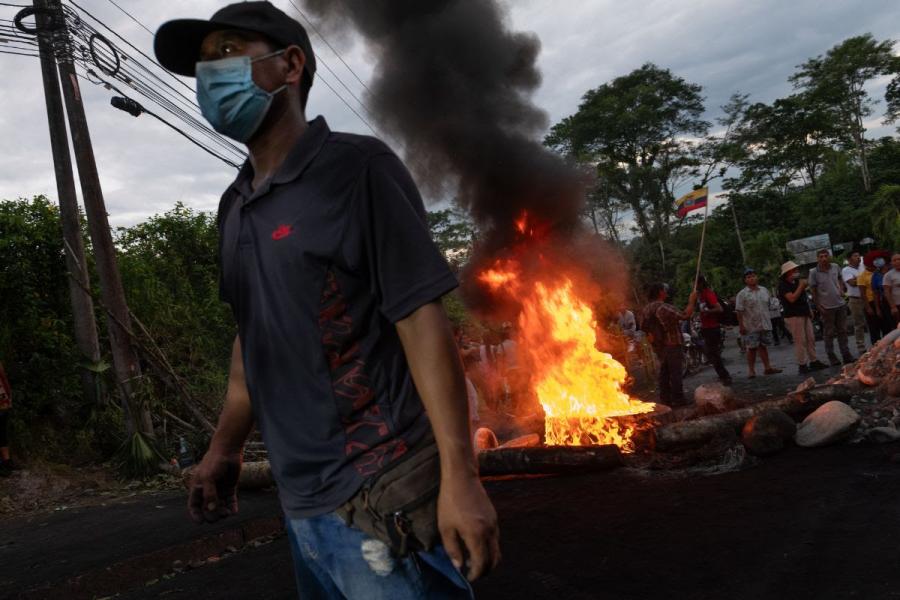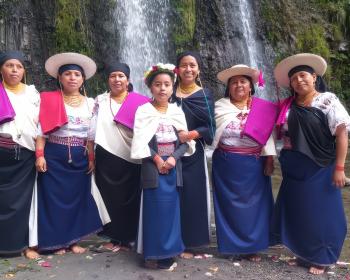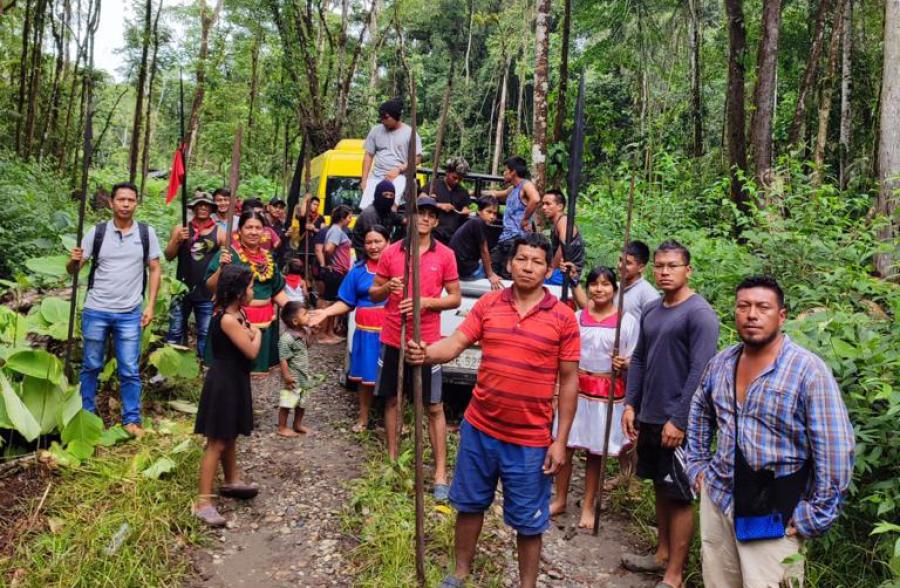By Nati Garcia
After a week of intense travel in Ecuador from the south of Guayaquil to the north of Imbabura, we finally made it to Cotacachi located in the “hoya” of Ibarra on the divine slopes of Cotacachi stratovolcano in the eastern part of the Andes. Only 20 minutes from Otavalo, Cotacachi has a completely different atmosphere, full of art, music, and peace.Here people have maintained their native language, Kichwa, which in other areas of Ecuador is being forgotten.
Arriving at the last stop in the center of the town, we found ourselves searching for a bus to San Pedro, a rural village outside of Cotacachi, to later be told that there was no transport available. We ended up taking a taxi which was a 10 min cobblestone ride up a steep hill. The taxi driver dropped us off at the entrance of San Pedro near an empty soccer playground. The crisp wind was anchoring us to join the dust it was taking along the way but the sun kept us strong and held our bodies to the earth.
A young boy bundled with a toque and wool sweater approached us and lead us to a house were one of the fellows selected for Cultural Survival’s Community Media Youth Fellowship was facilitating a workshop. The home was traditionally made out of mud, from the roof to the base of the house. Outside before the entrance of the house there was a small garden full of medicinal plants and flowers and in the center of the garden there was a mandala. Entering the home, we instantly felt warmth fill our bodies with gratitude. A group of mainly women and an elder all dressed in their traditional clothing were speaking among themselves in Kichwa. Among all the people in the room was Ñusta Sanchez beaming with joy when our eyes met. She was holding a audio recorder and deeply listening to an elder speak. We had entered in the moment when they were going to perform the last stage of a ceremony, the receiving of a life. They were preparing for the ceremony, laying out plants, a jar full of water, and other sacred items. This was all part of the ceremony, a vital practice that is being forgotten.
Cultural Survival’s Indigenous Youth Community Media Fellowship Project, a part of the Community Media Grants Project, aims to support Indigenous youth from the ages of 14 to 25 in building capacity in media, journalism, radio production, advocacy skills, technical abilities, and regional networking. Capacity of the fellows will be built through trainings, community radio exchanges, radio production, and conference attendance. This fellowship is an opportunity to enable the six fellows to successfully represent the voices of their communities and bring awareness of local issues to global conversations through their proposed projects.
Ñusta Sanchez is one of the six youth fellows taking initiative in maintaining and documenting these ceremonies so that is it not forgotten. When the moment came we embraced and exchanged a few words before the starting of the ceremony started. I noticed that a few people held handwoven wool dolls in their hands, each one was different. Sanchez went around interviewing participants and unwrapping the story of each doll. It was one of the first activities that they had done prior to the ceremony where participants made their own dolls to later gift to someone in the room. The receiver of the gift shared back in what the doll meant to her or him and how they felt in the moment of receiving it. There were people from all stages of life. At the end of the ceremony the children in the room gifted the elder with a bowl full of fruits. A cloth was laid out on the floor that was filled with corn, potatoes, meat for everyone to feast on together. We were received with affection and kindness.
Sanchez was anxious to meet us. It was an opportunity for her to meet me, the coordinator of the fellowship project, and her assigned Cultural Survival staff mentor, Avexnim Cojti, Community Media Grants Project Manger. Sanchez is one of those youth who silently sits in a circle but when giving the space to speak, she embodies wisdom and truth. She is an ancient spirit with a youthful mind, full of wonder and curiosity. We spoke about how her project was coming along and challenges she is having to overcome. This is her first project she is coordinating and has received support from one of her other local mentors, Christina who also resides in Cotacachi. It has been a unique experience for her because she is visiting communities outside of Cotacachi. Part of Sanchez’s project is to create a documentary radio series from all the workshops she is facilitating capturing the ancestral knowledge of Kichwa culture, language, medicine, ceremonies, and traditions. The youth fellowship project supports this process and we are proud to have Ñusta Sanchez as one of our first fellows.
Sánchez is an artist at heart, singing traditional Kichwa songs and is part of the Waruntzy dance group that represents threatened Abagos traditions. She recently completed her Bachelor's degree in Science with the Unidad Educativa “Luis Ulpiano de la Torre.” Ñusta, fluent in Kichwa and Spanish, manages a radio program “Don Dolon, Dolon” and radio documentary “Wawas” at Radio Cotacachi. Her fellowship project is to share ancestral knowledge in Kichwa with children, youth, and the participation of elders. She will create a radio series on leading cultural workshops based in experiential methodology, participatory action, and archiving documentation collected in a database for her community to access. She will also organize six trainings for children and youth in 18 Indigenous communities in her region in radio production.
Sanchez had a message to share with other youth, “My name is Ñusta Sanchez, I am from Santa Barbara community in Cotacachi, province of Imbabura from Ecuador. I am one of the youth fellows from Cultural Survival. I feel very proud and happy to be selected because I have had the opportunity to learn more about my community and other communities in Cotacachi. The Fellowship has also given other youth a chance to participate and learn. It is very important that other youth become involved in learning about different cultures from other communities and other aspects of our communities. It is important that youth participate because we are losing and forgetting our own cultures and traditions.”



